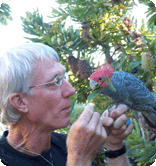Introducing a new bird

Dear EB, I have a 3 year old rose breasted cockatoo and I have been thinking about getting him a companion. What is the best way to introduce a new bird to him? Is it better for the new bird to be younger? Is he more likely to get along with another rose breasted cockatoo or will another bird his size be alright?
Thanks Jade

Dear Jade, That is a very difficult question to answer, especially from afar. As rose-breasted cockatoos can be quite aggressive to mates or perceived mates in a captivity situation, it follows that you must proceed very carefully.
First analyse whether your pet in fact WANTS another bird in the house or a companion. Many parrots are so attached to their owners that they resent a newcomer.
To choose another rose-breasted cockatoo would be a challenge. Again, dominance and jealousy and abuse can enter the scene and make matters problematic if not outright dangerous.
Under no circumstances would I choose a young female rose-breasted as your male will know it is a hen right away, and will try to get sexual with it long before she is ever ready to accept him as a partner. This means he will more than likely get aggressive and put fear into her at some point—leading to little chance she will be his preen partner for many many months if at all.
You could try another cockatoo species such as Goffin’s, even try a male bird in hopes that the two would become buddies without copulation or breeding needs being a serious issue. But the challenge here would be to find a trial basis for a companion before purchase (perhaps an understanding adoption agency) since if you purchase on speculation and the two birds do not get along, you will not be stuck with a second dilemma.
I have know lorikeets to befriend rose-breasteds, also amazons and greys have been know to befriend these pink cockatoos—Rosies by and large are touchy feely psittacines and take well to any affectionate bird as long as they are not jealous of you or intimidated by being pushed too quickly towards acceptance.
If you do decide on a parrot from another geographical continent—amazon or grey, then it would normally be okay to get a baby bird, either gender, and allow the two to interact slowly and gradually—sexual issues are usually minimal between parrot friends of totally unrelated genera.
Good luck, and keep the list posted.
You did not give your cockatoo’s name!
Aloha, EB

































